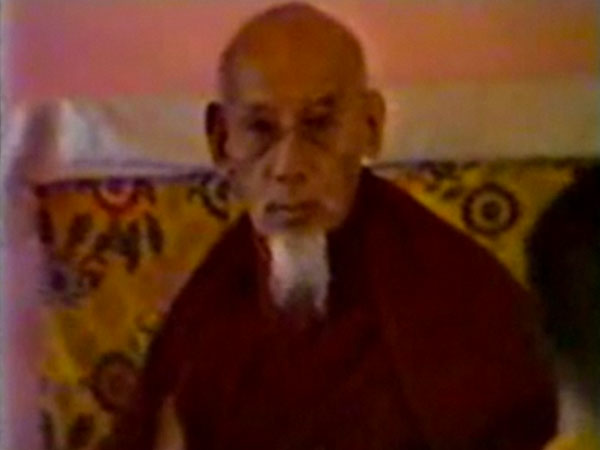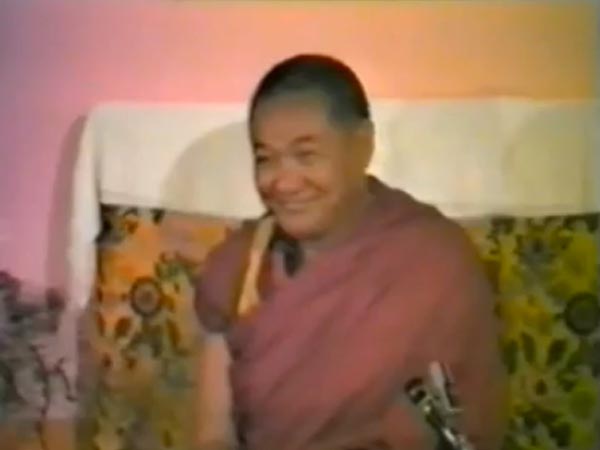DHARMA READINGS
| OFFERINGS - IMAGINARY OFFERINGS, ALTAR OFFERINGS... | | Print | |
Page 2 of 3
 Imaginary offerings In Tibet, in the centuries following the advent of Buddhism, rituals of offering, have taken countless forms. Offerings are laid out in a formal manner, according to specific instructions. This physical aspect of the offering is called the surpassable offering. It should be clean, honestly obtained, and offered with a proper motivation. However, the most important aspect of the offering in terms of merit, is not the physical aspect of the ritual cake or flowers, but what is imagined or meditated upon by the practitioner, the transformed aspect. This is called the unsurpassable offering. All the physical offerings arranged in rituals provide a basis for transformation into the unsurpassable offering. Because all Buddhist offerings originated in India, many of them retain characteristics of that land. As the practitioner progresses on the path, he or she becomes less dependent on such as basis. Other unsurpassable offerings consist of non-physical substances, such as offering virtue or the awakening mind. Because these offerings are created in our minds and are based on an understanding that all phenomena are empty of intrinsic existence, their potential is limitless. By making such offerings we can acquire limitless merit. To make an unsurpassable offering, the practitioner must have perfect motivation and a high level of meditative stabilization. If he or she can do the visualizations correctly, the splendour that appears to the mind will surpass the most exquisite mundane beauty. In the light of this the faults of ordinary existence, such as impermanence, appear obvious, which leads to a further loosening of attachment to the world and enhances the determination to be free.
Altar offerings According to the Buddhist scriptures, all the faults in the universe are the result of sentient beings disturbing emotions. Instead of dwelling on the faults to be seen in our offerings, but imagining them as pure and faultless, we create an imprint for purifying our minds of obstruction and defilement. Therefore they are imagined as pure and beautiful as possible, incorporating the best of everything existing in the past, present and future and the ten directions of the universe. The exalted beings to whom we make offerings do not apparently consume the physical substances before us. Nevertheless, as a basis for acquiring merit, such physical offerings should be clean, made of the best substances, attractive to ourselves and acquired through honest means. Consequently, they will form a better basis for imagining perfect offerings. When preparing to make offerings, we should begin by meditating on the wisdom of great bliss and emptiness, imagining it has taken the form of the offering. When making the offering, we should think of it as empty of intrinsic existence. In this way, we purify the offering of its ordinary aspects and also purify our minds. We should abandon any thought of immediate benefit, especially in relation to ourselves in this life. It is also important not to entertain doubts about the quality of our offering and whether or not it pleased the exalted being to whom we presented it. Instead, think that the deity rejoiced at the offering and generated great bliss from partaking of it.
Water-bowl offerings The first bowl contains clear water for the newly arrived guests to drink. The water should be imagined as pure as nectar and offered in vessels made of precious substances. In the second bowl is water for the guest to wash his or her feet; a reminder that in India people walked barefoot. In the third bowl are flowers, reminiscent of the crowns of flowers offered to women and the garlands offered to men. Masses of fragrant, beautiful flowers can be called up in the imagination. In the fourth bowl is incense, an offering to please the sense of smell. In the imagination, billowing clouds of fragrant incense are offered. The fifth offering, pleasing to sight, is bright light commonly in the form of a lamp, which, like the sun and the moon, illuminates darkness. This light is imagined to be so clear that you can see even the smallest atoms without obstruction. Sometimes, colored lights are offered and imagined to be emanating from nectar. In Tibetan tradition different colors are believed to have various healing properties. Colored or not, the light offered should be very clear. Light is imagined as dispelling the darkness of ignorance. Shariputra, the Buddhas main disciple renowned for his intelligence, had, in a previous life, offered a bright light before a stupa. As a result, he was reborn with great intelligence. The sixth offering consists of a bowl of scented water. Intended to soothe the mind, it is applied at the heart. Seventh is an offering of food, commonly in the form of a torma or ritual cake. In India, this offering traditionally contained three sweet substances: molasses, honey and sugar and three white substances: curd, butter and milk. In Tibet, these would be mixed with tsampa or parched barley flour to make an offering cake. The result is like ambrosia, pleasing in color, form, smell and taste. Eighth is an offering of sound. It is not represented on the altar, but can simply be imagined as beautiful music.
Offerings of the five sense objects 
Sensory Offerings Form Sound Smell Taste Touch To make these offerings a meditator vividly visualizes himself or herself as a deity, as described in the Tantras, generating what is known as divine pride in that identity. The meditator then visualizes making theses offerings, each of which is carried by an offering goddess. They are emanated from the meditators heart and either make offerings to the meditator manifested as a deity or to a deity visualized in front of him. These offerings give rise to great bliss in whoever they are offered to. Whatever tantric offerings we make should be qualified by three characteristics: their nature must be the wisdom of bliss and emptiness; their form should correspond to whatever is being offered; and they should have the power to induce uncontaminated bliss in the one they are offered to. By dissolving these offerings into the mandala deities, the practitioner gains a special power for inducing bliss. Once the particular offering has been made, each offering goddess dissolves back into the meditator's heart. There are many meditations for making unsurpassable offerings. Many involve the Bodhisattva Samantabhadra, who emerges from the meditator's heart, holding a jewel at his own heart. From this emerge countless more jewels, which spread all over the world making unsurpassable offerings. These can take the form of jewels, victory banners or any other beautiful object we can bring to mind. When non-physical offerings are made, they are given physical form to facilitate visualization. For example, in the Offering to the Spiritual Master, the practitioner makes an offering of his or her own spiritual practice in the following form: "On the shore of the wish-granting sea grow lotuses, Another common form of the unsurpassable offering is to offer the body, mind and roots of virtue.
Offering the Body Another reason for offering our body in its ordinary form is to seek protection. If a man offers his body to a king and the king accepts it, the man becomes the kings subject and as such enjoys his protection. Similarly seeking mere physical protection from exalted beings is the motivation of someone with limited aspirations. The desire for protection, however, can be extended beyond mere physical defence to protection from obstacles on the path to enlightenment. In exchange for pledging body, speech and mind to the attainment of enlightenment for the benefit of all sentient beings, the practitioner can receive support and protection from a meditational deity or Protector. We can also offer our body by transforming it into the aspect of a wish-fulfilling jewel which can satisfy the needs of all. From it emanate innumerable offerings in the form of jewels, victory banners, umbrellas and so forth which radiate out to all beings, from the enlightened Buddhas down to the most insignificant insects. Although the Buddha has no need for such offerings, great bliss arises in his continuum as a result of partaking from them. Bodhisattvas have almost completed the path to Buddhahood and we can imagine that our offerings clear away their last and subtlest obstructions to enlightenment. By offering our body, we can fulfil the wishes of beings in an equal or worse state to ourselves. We feed the hungry, clothe the poor, relieve the suffering of beings in worse states of rebirth and provide everything we can possibly imagine to whoever may need it. Another way of offering the body is to visualize it in the form of a deity, free from ordinary appearances. The aim of this practice is to put a stop to ordinary appearances and to attain the great bliss which is dependent on the six senses.
Offering wealth The greatest obstacle to purifying our vision is seeing things as they ordinarily appear. Special mantras are recited to help us prevent our perceiving phenomena in that way. According to the Buddhist explanation, things appear to us the way they do because of our disturbing emotions. Because all phenomena are empty of intrinsic existence, the way they appear to us and their actual mode of existence are different in nature. Since the way in which they appear reflects the state of our mind, purifying our minds will also purify our perception of ordinary appearances. In this way, it is possible to visualize a pea as a celestial mansion and then by making an offering of that celestial mansion to create corresponding merit. There are similar methods for making an offering of our environment. We first purify it of its impure elements and then offer it. We imagine ourselves surrounded by all the beings of the six realms of existence and, acting as their leader, offer our purified world to the Buddhas for the benefit of them all.
Offering the roots of virtue A practitioner on the path to enlightenment makes many pledges. Among these are pledges to give. Specifically, he or she pledges to make four kinds of gifts: material objects, Dharma, protection from fear, and love.
Material objects
Offering of Dharma
Offering of safety and protection
Offering of love
|
OTHER DHARMA READINGS
- A GUIDE TO SPIRITUAL PRACTICE
- DHARMA DEMYSTIFIED: NAGARJUNA, THE FOUNDER OF THE MAHAYANA TRADITION
- DORJE SHUGDEN ON BLACK HORSE
- WHY MANJUSHRI MATTERS
- DHARMA DEMYSTIFIED: THE ENTHRONEMENT OF DORJE SHUGDEN









